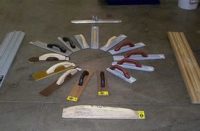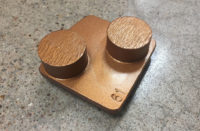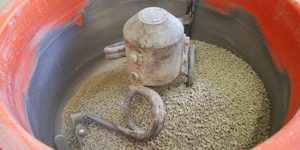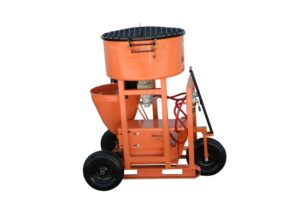Reliable. Multifaceted. Maintainable. Portable concrete mixers are all that and more, says Warren Faler, mixer product manager for Multiquip in Carson, Calif. “They can be productive in a wide variety of applications.”
Generally available in sizes ranging from 3 to 12 cubic feet, the smaller models will fit in the trunk of most cars while the larger capacity units can be towed easily. The versatility of a mixer makes it a cost-effective purchase, notes Faler. “Particularly with proper maintenance, these units will last for many years.”
![]() Independence and flexibility are clear advantages for contractors owning their own mixer, says Steve Louk, president of Cleform Tool and Gilson Mixers in St. Joseph, Mo. “Many ready-mix companies have a 3-yard minimum before they will deliver,” he says. “You also have to be able to pour during their working hours. With a portable mixer, you can mix as little or as much as you want, when you want. You control when and where you pour without depending on an outside vendor.”
Independence and flexibility are clear advantages for contractors owning their own mixer, says Steve Louk, president of Cleform Tool and Gilson Mixers in St. Joseph, Mo. “Many ready-mix companies have a 3-yard minimum before they will deliver,” he says. “You also have to be able to pour during their working hours. With a portable mixer, you can mix as little or as much as you want, when you want. You control when and where you pour without depending on an outside vendor.”
Faler says the biggest advantage in owning a portable mixer is realized when working on sidewalks, foundations and binding block, and when preparing mortar bases. Many decorative concrete contractors use portable mixers, too. He cited the monument works industry as an example in which many companies have mixers mounted on their own truck. “When they go to set a headstone,” says Louk, “they have everything they need with them. The same holds true for many of the landscape and fence builders.”
Louk says one of Gilson’s most popular models is a wheelbarrow-style mixer that will fit through a 30-inch-wide opening. “This allows the user to mix and pour right where the product is needed. With the interchangeable patented poly drums, there is no cross contamination of colors when using the Gilson Mixer,” Louk says.
When to call on ready-mix delivery
Faler says many factors — including job scope, location, staff size and deadline — should be weighed when choosing between a portable mixer and ready-mix delivery. “For instance, it is counterproductive for two contractors to use a portable concrete mixer when they need to pour a slab of 50 square feet. They are much better served using ready-mix. Similarly, if a job needs to be completed in an hour so contractors can move on to the next job, ready-mix is a smarter choice.”
 On the other hand, says Faler, contractors working in a back yard or space-restricted area where accessibility is a problem will find a portable mixer much more effective. Faler strongly recommends smaller mixers for mixing concrete to anchor fence posts; for patching; for small concrete slabs on grade; and for mixing non-stick grout. Larger-capacity models are better suited to high-production jobs such as concrete slabs, sidewalks and block walls. Adds Louk, “There are many styles and sizes to choose from, from a 2-cubic-foot pedestal style to a 31⁄2-cubic-foot wheelbarrow style to a 9-cubic-foot towable unit. The utility mixers start at 11⁄2 cubic feet and can be mounted to be made stationary; or an optional low- or high-speed tow kit can be added.”
On the other hand, says Faler, contractors working in a back yard or space-restricted area where accessibility is a problem will find a portable mixer much more effective. Faler strongly recommends smaller mixers for mixing concrete to anchor fence posts; for patching; for small concrete slabs on grade; and for mixing non-stick grout. Larger-capacity models are better suited to high-production jobs such as concrete slabs, sidewalks and block walls. Adds Louk, “There are many styles and sizes to choose from, from a 2-cubic-foot pedestal style to a 31⁄2-cubic-foot wheelbarrow style to a 9-cubic-foot towable unit. The utility mixers start at 11⁄2 cubic feet and can be mounted to be made stationary; or an optional low- or high-speed tow kit can be added.”
 Mixers are manufactured with either electric- or gasoline-powered sources, says Faler. “Single-phase electric motors are available in the 1⁄2- to 11⁄2-horsepower range while gas engines span from 3 to 13 horsepower. Mixers have speed controls that can be adjusted to fit the requirements of the specific job.”
Mixers are manufactured with either electric- or gasoline-powered sources, says Faler. “Single-phase electric motors are available in the 1⁄2- to 11⁄2-horsepower range while gas engines span from 3 to 13 horsepower. Mixers have speed controls that can be adjusted to fit the requirements of the specific job.”
Barrel design can vary — a little
The design of mixing barrels can vary, notes Louk. “Each Gilson  mixer features the Quad-Mixing System, a design exclusive to Gilson mixers. This system utilizes a four-piece, replaceable paddle-and-blade combination that creates four independent mixing patterns.” This design enhances overall batch quality and mixing efficiency.
mixer features the Quad-Mixing System, a design exclusive to Gilson mixers. This system utilizes a four-piece, replaceable paddle-and-blade combination that creates four independent mixing patterns.” This design enhances overall batch quality and mixing efficiency.
Most manufacturers offer steel and polyethylene drums to fit individual user preferences. “Steel drums are more durable, but cleaning can often be tedious,” says Faler, “and denting and other damage to the drum is a possibility. Poly drums, which resist rust, can be cleaned in minutes by simply tapping with a rubber mallet.”
 Per manufacturer recommendations, contractors should check the oil levels and filters of portable mixers daily, “Also, ensure that the mixer V-belts and pulleys are tight while necessary parts are greased regularly,” Faler says. Gears on a concrete mixer, however, should never be greased. Debris, sand, sediment or other material can become trapped in the gears, causing major damage to the unit, Faler says.
Per manufacturer recommendations, contractors should check the oil levels and filters of portable mixers daily, “Also, ensure that the mixer V-belts and pulleys are tight while necessary parts are greased regularly,” Faler says. Gears on a concrete mixer, however, should never be greased. Debris, sand, sediment or other material can become trapped in the gears, causing major damage to the unit, Faler says.
Gilson’s patented poly-drum mixers make it easy to maintain a clean mixing drum while reducing the need for drum replacement and repair, according to Louk. “Simple cleaning and lubrication will keep your mixer running trouble-free for years to come.”
















